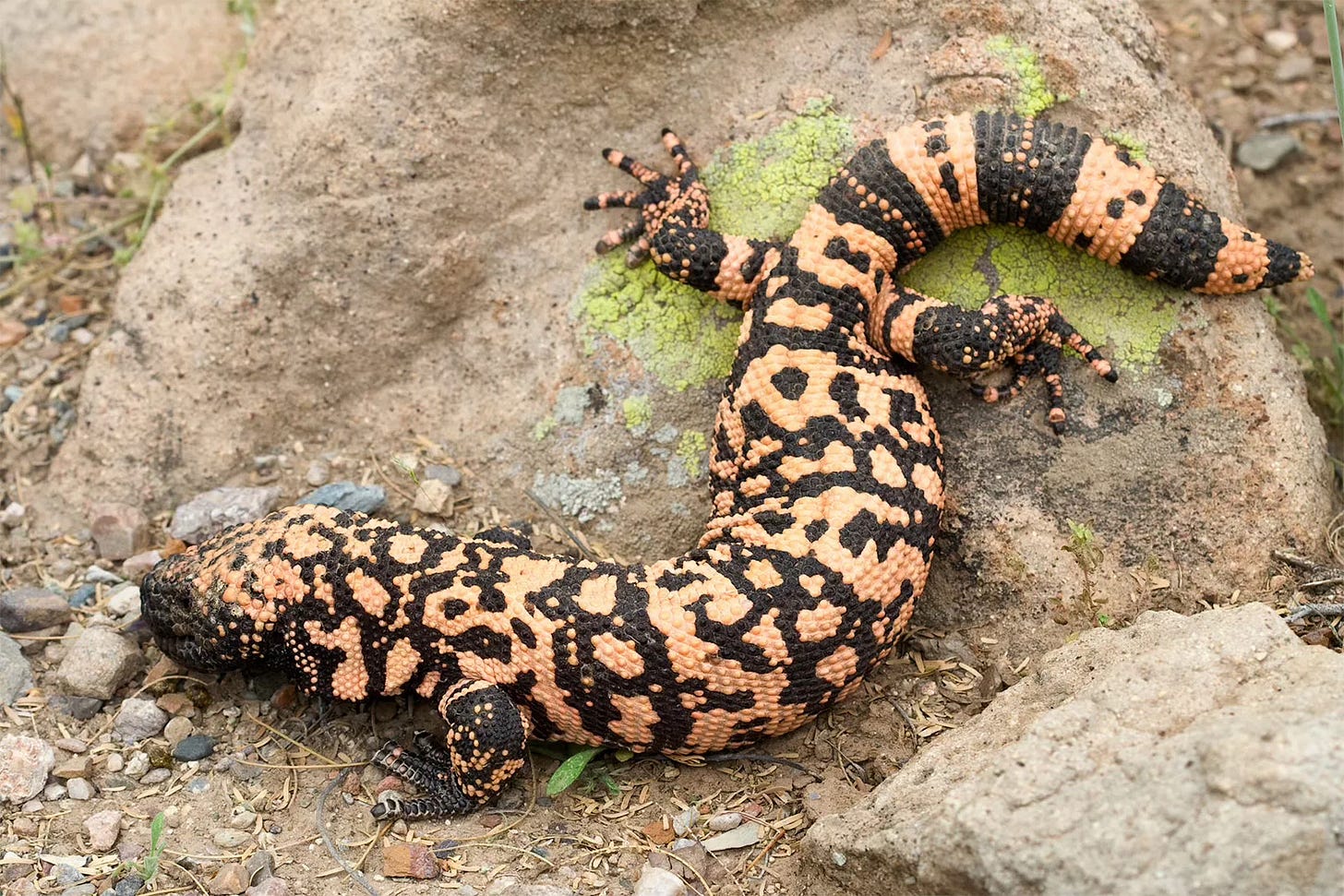
Hello Friends,
I want to share a shining example of the practice of humans’ innate terraphilia, our species affection for and affiliation with this earth and the planet’s web of life.
Meet Dr. Tim Cernak, a pharmaceutical chemist at the University of Michigan, who, after a career in Big Pharma developing drugs to fight cancer and other human diseases, pivoted to finding and testing medicines to help plants and non-human animals. (Thanks to Emily Anthes and her New York Times article, “On a Mission to Heal Gila Monsters.”)
Cernak was inspired to found the field he calls “conservation chemistry” by the many more-than-human species who had provided the compounds used for widely popular drugs, in particular, the digestion-slowing hormone obtained from venomous desert Gila monsters which yielded the blockbuster diet and diabetes drug Ozempic (semaglutide).
As Cernak points out, nature has provided humans with antibiotics derived from fungi (penicillin, ampicillin and the like), anticancer drugs from plants (Taxol and that class of drugs) and painkillers from animal venom (Ziconotide, a painkiller 1,000 times as potent as morphine, was derived from cone snail venom).
It is time, he says, for pharmaceutical chemists to reciprocate for these gifts: “To me it’s this full circle thing. We’re attempting to solve the ultimate health inequity.”
Pharma’s rad. But I wanted to apply my talents to a love of nature.
—Dr. Tim Cernak
So Cernak and his lab at University of Michigan are devoting their considerable knowledge and talents to finding, among other things, a drug that will cure a stubborn and deadly Cryptosporidium infection in a Gila monster who could live decades and contribute to the survival of her species if healthy, a drug that binds to the protein in the Chrytrid fungus that has decimated frog and other amphibian populations worldwide, a drug to combat bird flu in wild bird populations, and a cancer drug that would aid sea turtles, who, already stressed by climate change and warming oceans, are succumbing to a very contagious form of cancerous tumors.
Terraphilia in Action
Several things struck me when I read this article:
First, Dr. Cernak left a lucrative career in Big Pharma because he decided to “apply my talents to a love of nature,” in other words, practice his terraphilia. Cernak’s career pivot is a heartening example of where practicing terraphilia can take us, and of the reciprocal relationship with nature that Robin Wall Kimmerer talks about in her new book, The Serviceberry.
Second, who knew that Ozempic (semaglutide), which has been in the news in a huge way and is a multi-billion-dollar drug for Danish drugmaker Novo Nordic, was derived from a hormone found in a Gila monster? I didn’t. That fact was never mentioned in any article I read about the life-saving and life-changing drug and its breakthrough uses in humans. Nor have any of the billions of dollars from sales of Ozempic gone to help conserve the reptiles and their desert habitat, which is, quite ironically, endangered by industrial-scale solar energy development.
Third, Dr. Cernak’s work is a reminder of the heart at the core of science, the terraphilia that inspires our best and most lasting work.
Take heart. People everywhere are doing terraphilic work in this world. We can each add our own to the whole.
Blessings to you all, Susan




Thank you for this reminder that nothing we have or use is totally self-made. We have derived our drugs, our food, and our materials for structures from nature. The origins of our daily materials and food are all dependent on our planet.
As a biologist I often pointed out to my students that even the most reviled organisms may in the future produce something that we need. Although I have to confess that I did not always understand this, it became more and more apparent to me as I practiced as a field biologist. I looked on rattlesnakes, for example, as important beings in their own right, but their gifts to us took a longer time to understand. A friend of mine and I were returning from a visit to Mount Palomar in California and as we drove down the paved highway down the mountain we spotted a Pacific Rattlesnake trying to cross this very busy roadway. By this point I had started to have some respect for these animals and this was a beauty. It must have been freshly shed. The pattern was absolutely wonderful. My friend and I discussed what to do briefly but then we got out of his car and finally got the rather irritated snake off the road. We just couldn't bear the thought of this magnificent animal being flattened by an uncaring or even vengeful motorist.
I later discovered that venoms of snakes have produced enough drugs and antivenoms to have our respect, even if we are at some level afraid of them or are disgusted by them (See: https://pmc.ncbi.nlm.nih.gov/articles/PMC6832721/. )
It was a great tragedy when part of the Butantan Institute in Brazil burned to the ground, taking with it their collection of venomous organisms on which they based their discovery of important chemicals, starting with antivenoms.
In short, there is a practical and scientific reason to have respect for all organisms from Gila Monsters to Slime Molds.It is a great pity that many of us don't see that.
Reciprocity.
Way beyond transactional.
Virtuous spirals, loops.